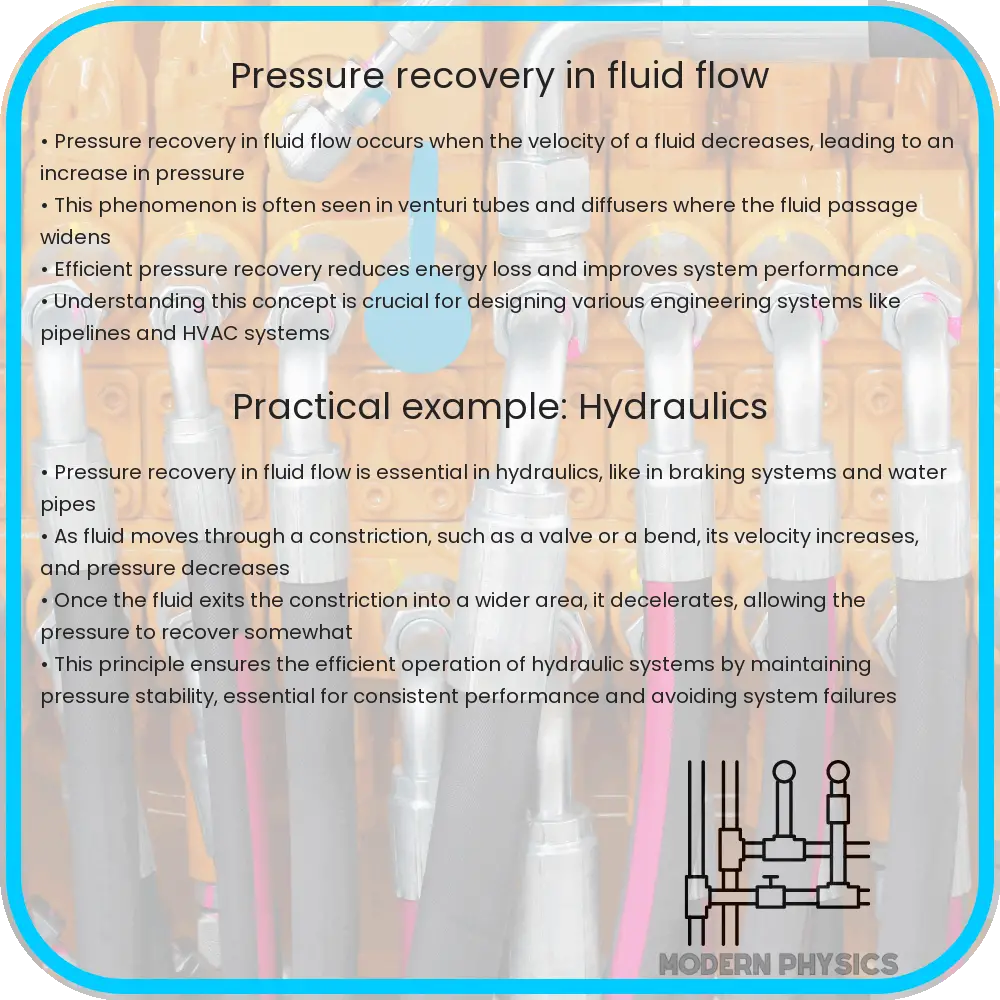Explore the essentials of pressure recovery in fluid flow, covering efficiency, optimization strategies, and diverse industry applications.

Understanding Pressure Recovery in Fluid Flow
Pressure recovery in fluid dynamics is a critical concept, particularly in systems where fluid flow efficiency is paramount. This phenomenon occurs when the static pressure in a flowing fluid increases after it has passed through a constricted area, such as a valve or an orifice. Understanding and optimizing pressure recovery is essential in various engineering applications, from pipeline design to aerodynamics.
Efficiency in Pressure Recovery
The efficiency of pressure recovery is a measure of how effectively a system can regain static pressure after experiencing a drop. This efficiency is influenced by several factors, including the geometry of the flow path, fluid properties, and the flow regime. Higher pressure recovery efficiency leads to better overall performance of the fluid system, reducing energy losses and enhancing operational effectiveness.
Optimization Strategies
Optimizing pressure recovery involves a multifaceted approach, addressing both design and operational aspects. Key strategies include:
- Streamlining flow paths to minimize turbulence and resistance.
- Choosing materials and coatings that reduce friction and wear.
- Implementing advanced flow control methods to regulate flow dynamics.
Design Considerations
The design of components such as valves, pipes, and fittings plays a crucial role in pressure recovery. Designers must balance factors such as size, shape, and material choice to maximize efficiency. Computational fluid dynamics (CFD) simulations are often employed to predict pressure recovery characteristics and guide design decisions.
One critical aspect in design is the consideration of the Reynolds number (Re), defined as Re = ρuL/μ, where ρ is the fluid density, u is the velocity, L is a characteristic length, and μ is the dynamic viscosity. The Reynolds number helps in determining whether the flow is laminar or turbulent, which significantly impacts pressure recovery.
In conclusion, pressure recovery in fluid flow is a fundamental aspect of fluid dynamics, with significant implications for the efficiency and optimization of fluid systems. The next section will delve deeper into specific examples and applications, illustrating the practical significance of pressure recovery in various industries.
Applications and Examples of Pressure Recovery
Pressure recovery is utilized in a variety of fields, demonstrating its versatility and importance. For instance, in the aerospace industry, the design of air intakes in jet engines relies heavily on optimizing pressure recovery to maximize engine efficiency. In hydraulic systems, pressure recovery is critical in the design of pumps and valves to ensure minimal energy loss and optimal fluid control.
Case Studies in Pressure Recovery
A notable example can be found in the design of Venturi tubes, which are used in fluid metering. These devices utilize the principle of pressure recovery by causing the fluid to speed up in a constricted section and then slow down, recovering pressure in a diverging section. This behavior follows the Bernoulli’s principle, which states that an increase in fluid velocity leads to a decrease in pressure, and vice versa.
Another application is in the automotive industry, where pressure recovery plays a role in the design of fuel systems and engine cooling. Efficient fluid flow management ensures better fuel economy and engine performance.
Challenges and Future Directions
Despite the advancements in understanding and optimizing pressure recovery, challenges remain. For example, in high-speed flows, achieving efficient pressure recovery without causing flow separation or instabilities can be difficult. Additionally, in multi-phase flows, such as in oil and gas pipelines, the presence of different phases (liquid, gas, solid) adds complexity to pressure recovery dynamics.
The future of pressure recovery involves further research and development in materials science, fluid dynamics, and computational modeling. Advances in these areas will enable more precise control and optimization of fluid flow, leading to even greater efficiencies in various applications.
Conclusion
Pressure recovery in fluid flow is a crucial concept that impacts a wide range of industries. Its efficiency and optimization are vital for energy conservation, operational effectiveness, and overall system performance. As technology advances, the understanding and application of pressure recovery will continue to evolve, offering new opportunities for innovation in fluid dynamics. By addressing the challenges and harnessing the potential of pressure recovery, engineers and scientists can significantly contribute to the development of more efficient and sustainable fluid systems.
